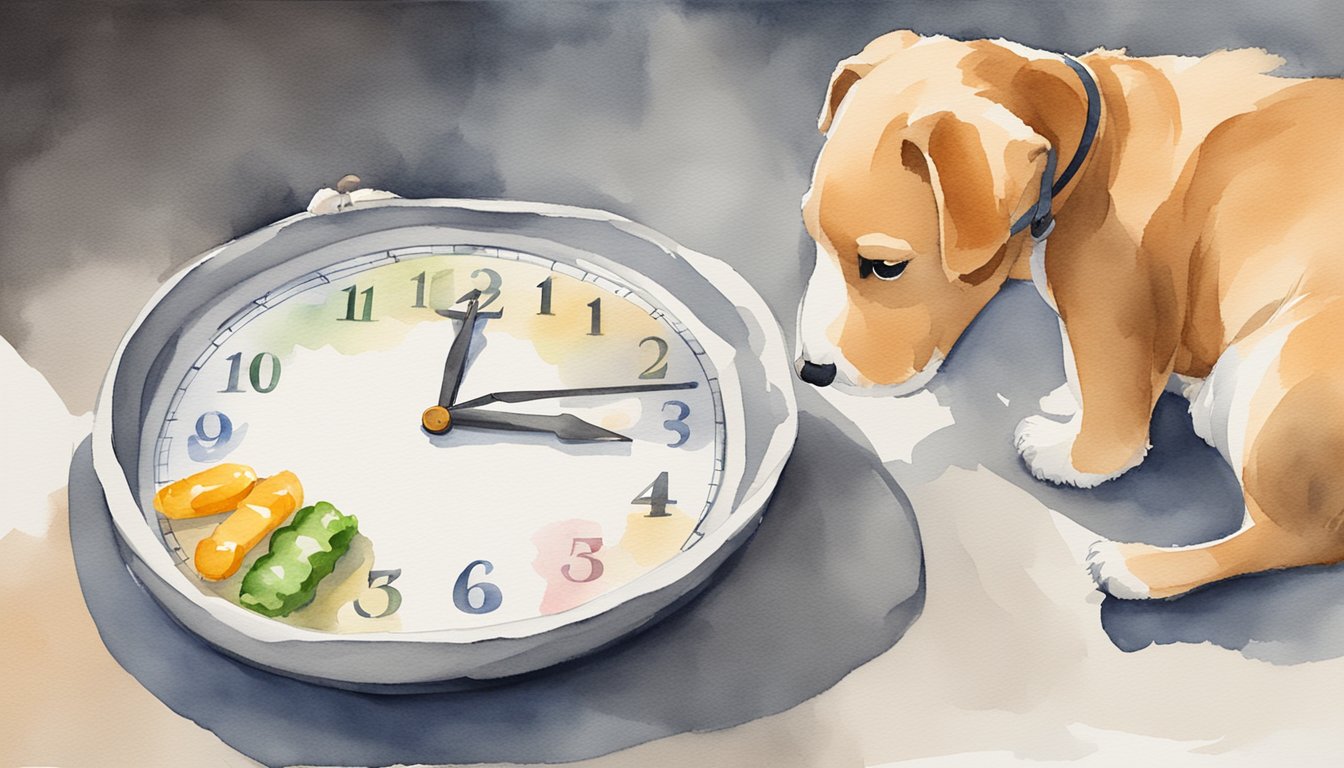Determining Your Dog’s Dietary Needs
When it comes to feeding, a dog’s age, size, and level of activity play pivotal roles in deciding how often they should eat. Let’s chew over the specifics to serve up the perfect meal plan for your furry friend.
Assessing Age and Life Stage
Puppies, with their high-energy antics, often require more frequent meals — as many as 3 to 4 times a day. They’re growing at a rapid pace and need plenty of nutrients to support this growth. On the other hand, an adult dog may thrive on two meals a day. For senior dogs, who may have slower metabolisms, it’s important to tailor their intake to their decreasing energy needs, potentially reducing feeding frequency to prevent weight gain.
Considering Size and Breed Specifics
The nutritional needs can vary significantly between a stout Yorkshire Terrier and a towering Great Dane. Large breed dogs may need fewer calories per pound than smaller breeds, due to differences in metabolism. One must also consider the breed-specific quirks; for example, some breeds are predisposed to obesity and require careful meal planning.
Accounting for Health and Activity Level
An active dog who’s always on the move will need more calories than a couch potato pup. Health issues or medical conditions also have a direct impact on dietary requirements — a dog with diabetes, for instance, will need a diet tailored to manage blood sugar levels. It’s imperative to monitor their weight and body condition, adjusting their diet as needed to maintain optimum health.
Creating a Feeding Schedule

When welcoming a furry friend into your home, establishing a suitable feeding routine is vital for their health and happiness. It’s about finding the sweet spot between nutritional needs and daily structure.
Meals Per Day and Portion Sizes
Determining the right number of meals involves considering the dog’s age, breed, and activity level, but typically adult dogs thrive on two meals per day. Portion sizes should match their size and energy expenditure, preventing malnutrition or obesity. For detailed guidance tailored to your dog, visit Feeding the healthy dog and cat which elaborates on these energy requirements.
- Puppies: Generally require 3-4 meals a day to support their growth.
- Adult dogs: Most fare well with two meals a day.
- Senior dogs: May need adjustments to meal size or frequency depending on their health.
Understanding Feeding Types
The type of food you choose, whether it’s dry food, canned food, or a combination, affects your feeding schedule. Dry food, convenient and less perishable, can be left out longer, possibly allowing for a more flexible schedule. In contrast, canned food is best for defined meal times due to its perishability. Refer to insights from Nutrient requirements of dogs and cats on nutritional content and feeding practices.
- Dry Food: Allows for “free-feeding” or timed portions.
- Canned Food: Requires adherence to meal times due to potential spoilage.
Adjusting the Routine Over Time
A dog’s feeding schedule isn’t set in stone. Adjustments may be necessary due to age, health changes, or even life transitions. Monitor your dog’s health and be flexible. For example, the feeding routine for a dog that’s slowing down due to age might differ from an active adult dog’s. The article What the technician should know about feeding behavior of dogs and cats provides an expert’s take on feeding behavior, which can be instrumental in shaping an ideal feeding schedule.
- Life Stage Adjustments: Growing puppies, adult dogs, and seniors will have different dietary and scheduling needs.
- Health-Related Adjustments: Health issues might call for more frequent, smaller meals or dietary changes.
Considering Food Types and Meal Content

When it comes to feeding our furry companions, the type of dog food and meal content play crucial roles. There’s more to feeding a dog than just filling the bowl; one must consider calorie content, nutrition, and how different foods affect a dog’s health.
Choosing the Right Dog Food
Selecting the appropriate food for a dog is much like a balancing act. Dogs require a diet that provides the right amount of calories and nutrition to maintain their health without leading to weight gain or conditions like bloat. A high-quality pet food will list a protein like meat, fish, or poultry as the first ingredient on the label. Portion sizes should be adjusted to the dog’s size, age, and activity level.
While dry kibble is a popular choice due to its convenience and long shelf-life, it’s essential to look at the calorie content to prevent overfeeding. Some brands excel in offering balanced nutrition with appropriate portion sizes, such as specific brands known for nutritious dog food. Free feeding, or leaving food available for dogs to graze all day, is not recommended for most dogs, as it can lead to weight gain.
Incorporating Treats and Training
Treats can be an effective training tool, but they should be used judiciously. It’s important to account for treats within the daily calorie allowance to prevent overweight dogs, perhaps sticking to options that are both low in calories and rich in nutrients. For instance, using pieces of carrot or apple can be healthy, low-calorie choices. According to a study on dog caregivers’ perceptions and behaviors regarding feeding treats, moderation is key, and offering too many treats can disrupt a dog’s appetite for their regular meals.
Moreover, some pet parents might be surprised to learn that the nutrients and calorie content of treats vary widely, which should be a consideration in a dog’s overall diet to maintain optimal health. When used correctly, treats can enhance a training program without compromising nutrition.

